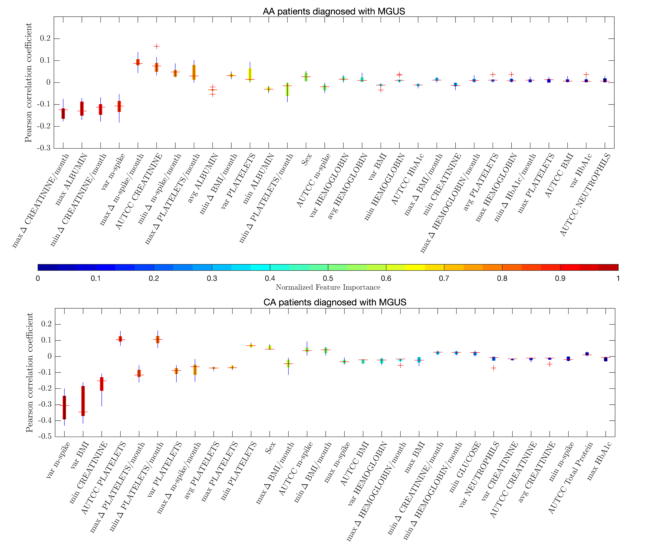
Click to Enlarge: In both AAs and CAs, m-spike, platelets, and creatinine were the most influential predictors of progression from MGUS to MM. In addition to low m-spike for AA patients, stable creatinine and albumin levels predict reduced risk of progression. In CA patients, stable BMI, creatinine, and platelet levels predict reduced risk of progression. Our findings may contribute to improved prediction of progression for patients diagnosed with MGUS. Source: 64th Annual ASH Meeting and Exposition
ST. LOUIS — While it is widely known that African Americans (AA) are at higher risk for multiple myeloma (MM), precisely what factors create the disparity are not well understood.
A study team from the St. Louis VAMC and Washington University School of Medicine in St. Louis sought to use machine learning and electronic health records to assess racial differences in predictors for MM in patients diagnosed with monoclonal gammopathy of undetermined significance (MGUS), the pre-malignant condition of MM.
Results were presented recently at the 64th Annual ASH Meeting and Exposition in New Orleans.1
For the study, the researchers identified veterans diagnosed with MGUS from 1999-2021 with the VHA. A natural language processing-based algorithm was used to determine MGUS diagnosis and progression to smoldering MM and MM. Excluded were veterans who were neither Caucasian (CA) nor African American, as well as those with diabetes mellitus, which can interact with MM progression.
The researchers took into account the following potential predictors:
- age,
- sex,
- time-varying weight,
- height (for body mass index, BMI),
- monoclonal (m)-spike,
- creatinine,
- hemoglobin,
- hemoglobin A1C,
- platelets,
- neutrophils,
- albumin, and
- total protein.
The study team did an analysis of 16,430 (72.1% CAs and 27.9% AAs) MGUS patients. Average area under the ROC curve (AUC) score was 0.79 (95% confidence interval, CI, 0.76-0.82) for Caucasians and 0.83 (95% CI 0.81-0.86) for African Americans.
The top risk factors for progression in AA patients were max increase of m-spike (r=0.11, 95% CI 0.08-0.14), creatinine AUC (r=0.11, 95% CI 0.07-0.14), and max decrease of m-spike (r=0.06, 95% CI 0.07-0.08); the top protective factors were max increase of creatinine/month (r=-0.32, 95% CI -0.40, -0.23), max albumin (r=-0.29, 95% CI -0.40, -0.20), and max decrease of creatinine/month (r =-0.18, 95% CI -0.25, -0.11).
For CA patients with MGUS, the top risk factors for progression were platelets AUC (r=0.09, 95% CI 0.08-0.11), max decrease of platelets/month (r=0.08, 95% CI 0.05-0.10) and min platelets (r=0.05, 95% CI 0.02-0.07), while the top protective factors were var m-spike (r=-0.13, 95% CI -0.15, -0.11), var BMI (r=-0.12, 95% CI -0.15, -0.10), and min creatinine (r=-0.12, 95% CI -0.14, -0.1).
“In both AAs and CAs, m-spike, platelets, and creatinine were the most influential predictors of progression from MGUS to MM,” the authors concluded. “In addition to low m-spike for AA patients, stable creatinine and albumin levels predict reduced risk of progression. In CA patients, stable BMI, creatinine, and platelet levels predict reduced risk of progression. Our findings may contribute to improved prediction of progression for patients diagnosed with MGUS.”
- Yu Y, Eang M, Liu L, Thomas TS, et. al. Racial Difference in Dynamic Markers for Progression of MGUS Using Machine Learning Approaches. Presented at the 64th Annual ASH Meeting and Exposition; December 2022; New Orleans, LA

